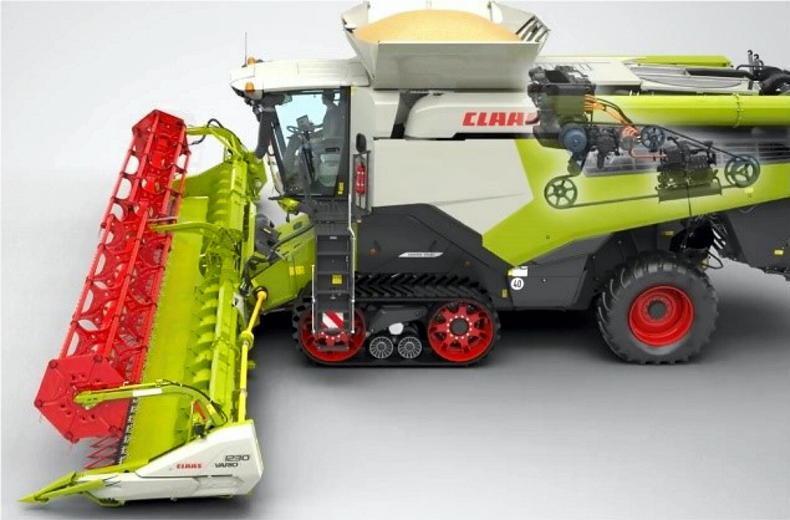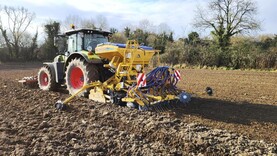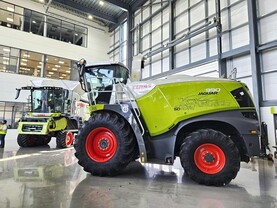This year, Claas has carried out field tests on a hybrid, semi-electric drive combine harvester concept.
Why? Well, Claas feels that such a concept has the potential to help flatten load peaks and significantly increase efficiency.
It also allows for smaller combustion engines that run at lower rpm to be fitted to combines without compromising on output.
How does it work?
When harvesting conditions are straightforward, excess engine power that’s not required for the combine drive is converted to electrical energy via a generator and stored in the battery.

The hybrid drive assembly.
When harvesting conditions become difficult, such as in higher yielding areas or when discharging on the move, the electric motor kicks in to support the mechanical drive by using stored electrical energy from the battery.
The idea here is to replace a conventional boost produced by the engine performance.
Claas says that this enables load peaks to be bridged for several seconds and, with automatic load distribution, the combine can consistently operate in the optimum performance range.
What are the benefits?
This concept allows a smaller, less powerful engine with an output of around 540hp (400kW) to be operated in the low-speed range at 1,600rpm instead of 1,800rpm.
This is compensated for thanks to the additional 40kW electric motor and 3kWh battery with a 48V inverter. In field trials, Claas says this semi-electric hybrid concept reduced fuel consumption by up to 10%.

At Agritechnica, the firm said the concept is still very much at the early stages of testing and time will tell whether or not the concept makes it to the production stage.
The manufacturer says that since the electric drive operates in the low-voltage range (<60V touch voltage), it does not require the complex safety precautions associated with higher-voltage drives.
Claas says that this means that maintenance can be carried out without further safety measures or special training.
At Agritechnica, the firm said the concept is still very much at the early stages of testing and time will tell whether or not the concept makes it to the production stage.
This year, Claas has carried out field tests on a hybrid, semi-electric drive combine harvester concept.
Why? Well, Claas feels that such a concept has the potential to help flatten load peaks and significantly increase efficiency.
It also allows for smaller combustion engines that run at lower rpm to be fitted to combines without compromising on output.
How does it work?
When harvesting conditions are straightforward, excess engine power that’s not required for the combine drive is converted to electrical energy via a generator and stored in the battery.

The hybrid drive assembly.
When harvesting conditions become difficult, such as in higher yielding areas or when discharging on the move, the electric motor kicks in to support the mechanical drive by using stored electrical energy from the battery.
The idea here is to replace a conventional boost produced by the engine performance.
Claas says that this enables load peaks to be bridged for several seconds and, with automatic load distribution, the combine can consistently operate in the optimum performance range.
What are the benefits?
This concept allows a smaller, less powerful engine with an output of around 540hp (400kW) to be operated in the low-speed range at 1,600rpm instead of 1,800rpm.
This is compensated for thanks to the additional 40kW electric motor and 3kWh battery with a 48V inverter. In field trials, Claas says this semi-electric hybrid concept reduced fuel consumption by up to 10%.

At Agritechnica, the firm said the concept is still very much at the early stages of testing and time will tell whether or not the concept makes it to the production stage.
The manufacturer says that since the electric drive operates in the low-voltage range (<60V touch voltage), it does not require the complex safety precautions associated with higher-voltage drives.
Claas says that this means that maintenance can be carried out without further safety measures or special training.
At Agritechnica, the firm said the concept is still very much at the early stages of testing and time will tell whether or not the concept makes it to the production stage.








 This is a subscriber-only article
This is a subscriber-only article










SHARING OPTIONS: